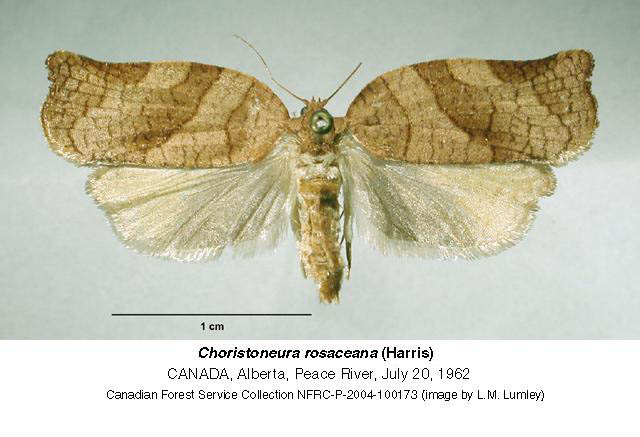« Back to your search
Species Details
Choristoneura rosaceana
University of Alberta E.H. Strickland Entomological Museum Read more about this collection »
Common NameOblique-banded leafroller
SeasonalityAdult flight from early June through August; 2nd flight can occur in mid to late August.
IdentificationLarvae dark green or brown with brown to black head at maturity. Pupa dark, reddish brown and usually found in folded leaves. Adults brownish red with darker, oblique band across center of forewing (Furniss & Carolin 1977). Wingspread approx 25 mm. Hind wing light in color with fringe along posterior edge.
Scientific Name
Choristoneura rosaceana
Common Name
Oblique-banded leafroller
Habitat
Deciduous woodlands.
Seasonality
Adult flight from early June through August; 2nd flight can occur in mid to late August.
Identification
Larvae dark green or brown with brown to black head at maturity. Pupa dark, reddish brown and usually found in folded leaves. Adults brownish red with darker, oblique band across center of forewing (Furniss & Carolin…
Larvae dark green or brown with brown to black head at maturity. Pupa dark, reddish brown and usually found in folded leaves. Adults brownish red with darker, oblique band across center of forewing (Furniss & Carolin 1977). Wingspread approx 25 mm. Hind wing light in color with fringe along posterior edge.
Life History
Adults emerge in mid to late June and eggs are laid shortly thereafter. Larvae emerge in approximately 2 weeks and typically disperse on silken threads. Larvae start feeding and then either enter diapause in a…
Adults emerge in mid to late June and eggs are laid shortly thereafter. Larvae emerge in approximately 2 weeks and typically disperse on silken threads. Larvae start feeding and then either enter diapause in a sheltered place in second or third instar or continue development for a second generation. If second generation is produced, the larvae enter diapause and hibernate in second or third instar. Larvae emerge after leaf-flush in the spring and start feeding again. On fruit trees, the larvae feed on floral parts within bud clusters, continue feeding on flowers during bloom, and eventually feed on fruit and expanding leaves. Larvae typically pupate after sixth larval instar. Populations vary from mostly producing one generation per year in northern climates to mostly producing two generations per year in southern, warmer climates (EPPO 2004, Hunter & McNeil 1997, Hunter & McNeil 2000).
Conservation
Not of concern.
Diet Info
Polyphagous, but prefers hosts from the Rosaceae family. It is considered a pest in apple, pear, and peach orchards. It also occurs on soft fruits such as blueberries and raspberries, on ornamental shrubs, on a wide…
Polyphagous, but prefers hosts from the Rosaceae family. It is considered a pest in apple, pear, and peach orchards. It also occurs on soft fruits such as blueberries and raspberries, on ornamental shrubs, on a wide variety of other deciduous tree species (EPPO 2004), and has occasionally been found feeding on pines (Otvos 1991).
Range
Widely distributed species in temperate North America. Most commonly found in the West at low elevations except the arid Southwest (EPPO, Furniss & Carolin 1977).
References
Author
Northern Prairie Wildlife Research Centre.
Title
Caterpillars of Pacific Northwest Forests and Woodlands: Choristoneura rosaceana (Tortricidae).
Publication Date
2004
Author
Hunter, M. D., and J. N. McNeil
Title
Geographic and parental influences on diapause by a polyphagous insect herbivore.
Publication Date
2000
Series Title
Agricultural and Forest Entomology
Volume
2
Pages
49-55
Author
Hunter, M. D., and J. N. McNeil
Title
Host-plant quality influences diapause and voltinism in a polyphagous insect herbivore.
Publication Date
1997
Series Title
Ecology
Volume
78
Pages
977-986
Author
Otvos, I. S.
Title
North American Species in Forestry.
Publication Date
1991
Pages
719-756
Author
European and Mediterranean Plant Protection Organization (EPPO).
Title
Plant Quarantine Data Retrieval System.
Publication Date
2004
Author
Furniss, R. L., and V. M. Carolin
Title
Western Forest Insects.
Publication Date
1977
Pages
172-173
Specimen Information
There are 149 specimens of this Species.
BIRD37814 - Choristoneura rosaceana
University of Alberta E.H. Strickland Entomological Museum
Place CollectedCanada: Alberta, Erskine
Collected ByBird, C. D.
Date Collected2015-07-02
BIRD37815 - Choristoneura rosaceana
University of Alberta E.H. Strickland Entomological Museum
Place CollectedCanada: Alberta, Winfield
Collected ByBird, C. D.
Date Collected2015-08-03



